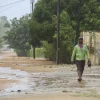Incessant rainfall has led to what is being described as the worst flood crisis in Tripura, a state in northeastern India, in the past thirty years.
Persistent heavy showers from Monday through Wednesday have resulted in rivers surpassing danger and extreme danger levels, causing significant flooding. This disaster has tragically claimed the lives of ten individuals and displaced over 34,000 residents.
The southern districts of Tripura have been particularly hard hit. Those displaced are being accommodated in the northern parts of the state.
On Wednesday alone, rainfall totals were staggering, with Bagafa recording 375.8 mm and Belonia 324.4 mm. The severe weather prompted the closure of schools and the suspension of classes at Tripura University on Wednesday.

The heavy rains are attributed to a low-pressure system located over Bangladesh, which is gradually moving westward into northeastern India. Forecasts indicate that the situation may worsen, with an additional 100-150 mm of rain expected through Thursday and Friday, maintaining the threat of further flooding.
Bangladesh is also grappling with severe flooding, affecting nearly 3 million people. The flooding has caused roadways to become impassable, isolating millions and disrupting relief efforts.
Residents have been forced to evacuate via boats and other makeshift means. The same low-pressure system causing devastation in Tripura is also responsible for the floods in Bangladesh, with worsening conditions anticipated.
In the eastern Pacific, Hurricane Gilma has rapidly intensified into a category 3 hurricane, with sustained winds of 115 mph. Located about 1,000 miles off the California peninsula, Gilma is the first major hurricane of the season in this region.
It is expected to track west-northwest over the coming days before gradually weakening. No coastal watches or warnings are in effect, but the National Hurricane Center continues to monitor the storm’s progress.

